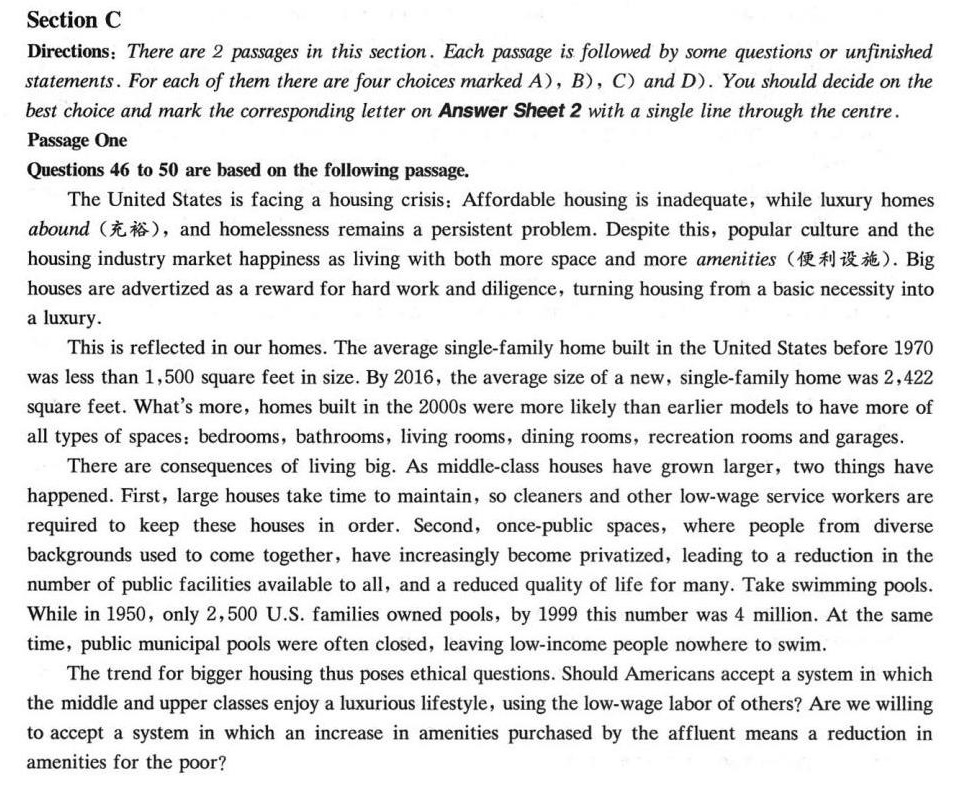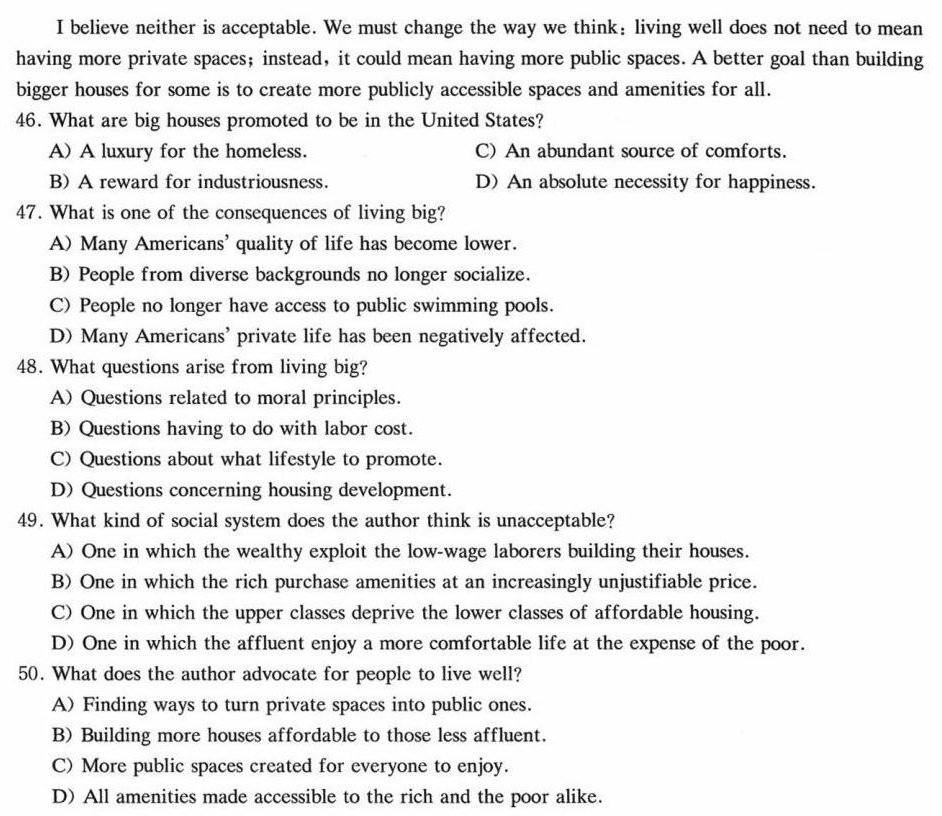题目
Section C-|||-Directions: There are 2 passages in this section.Each passage is followed by some questions or unfinished-|||-statements.For each of them there are four choices marked A),B),C)and D).You should decide on the-|||-best choice and mark the corresponding letter on Answer Sheet 2 with a single line through the centre.-|||-Passage One-|||-Questions 46 to 50 are based on the following passage.-|||-The United States is facing a housing crisis: Affordabl housing is inadequate,while luxury homes-|||-abound(充裕),and homelessness remains a persistent problem.Despit this,popular culture and the-|||-housing industry market happiness as living with both more space and more amenities(便利设施).Big-|||-houses are advertized as a reward for hard work and dilligence,turning housing from a basic necessity into-|||-a luxury.-|||-This is reflected in our homes.The average single-family home built in the United States before 1970-|||-was less than 1,500square feet in size.By 2016,the average size of a new,single-family home was 2,422-|||-square feet.What`s more, homes built in the 2000s were more likely than earlier models to have more of-|||-all types of spaces: bedrooms, bathroo living rooms,dining rooms,recreation rooms and garages.-|||-There are consequences of living big.As middle-class houses have grown larger,two things have-|||-happened.First, large houses take time to maintain,so cleaners and other low-wage service workers are-|||-required to keep these houses in order.Second, once-public spaces, where people from diverse-|||-backgrounds used to come together, have increasingly become priva leading to a reduction in the-|||-number of public facilities available to all,and a reduced quality of life for many.Take swimming pools.-|||-While in 1950,only 2,500 U.S.families owned pools,by 1999 this number was 4million.At the same-|||-time,public municipal pools were often closed,leaving low income people nowhere to swim.-|||-The trend for bigger housing thus poses ethical questions.Should Americans accept a system in which-|||-the middle and upper classes enjoy a luxurious lifestyle,using the low wage labor of others?Are we willing-|||-to accept a system in which an increase in amenities purchased by the affluent means a reduction in-|||-amenities for the poor?Section C-|||-Directions: There are 2 passages in this section.Each passage is followed by some questions or unfinished-|||-statements.For each of them there are four choices marked A),B),C)and D).You should decide on the-|||-best choice and mark the corresponding letter on Answer Sheet 2 with a single line through the centre.-|||-Passage One-|||-Questions 46 to 50 are based on the following passage.-|||-The United States is facing a housing crisis: Affordabl housing is inadequate,while luxury homes-|||-abound(充裕),and homelessness remains a persistent problem.Despit this,popular culture and the-|||-housing industry market happiness as living with both more space and more amenities(便利设施).Big-|||-houses are advertized as a reward for hard work and dilligence,turning housing from a basic necessity into-|||-a luxury.-|||-This is reflected in our homes.The average single-family home built in the United States before 1970-|||-was less than 1,500square feet in size.By 2016,the average size of a new,single-family home was 2,422-|||-square feet.What`s more, homes built in the 2000s were more likely than earlier models to have more of-|||-all types of spaces: bedrooms, bathroo living rooms,dining rooms,recreation rooms and garages.-|||-There are consequences of living big.As middle-class houses have grown larger,two things have-|||-happened.First, large houses take time to maintain,so cleaners and other low-wage service workers are-|||-required to keep these houses in order.Second, once-public spaces, where people from diverse-|||-backgrounds used to come together, have increasingly become priva leading to a reduction in the-|||-number of public facilities available to all,and a reduced quality of life for many.Take swimming pools.-|||-While in 1950,only 2,500 U.S.families owned pools,by 1999 this number was 4million.At the same-|||-time,public municipal pools were often closed,leaving low income people nowhere to swim.-|||-The trend for bigger housing thus poses ethical questions.Should Americans accept a system in which-|||-the middle and upper classes enjoy a luxurious lifestyle,using the low wage labor of others?Are we willing-|||-to accept a system in which an increase in amenities purchased by the affluent means a reduction in-|||-amenities for the poor?


题目解答
答案






解析
步骤 1:理解问题背景
文章讨论了美国住房危机,包括可负担住房不足、豪华住宅过剩和无家可归问题。同时,文章指出,尽管存在这些问题,但流行文化和住房行业却将拥有更多空间和便利设施的生活视为幸福的标志。大房子被宣传为勤奋工作的奖励,将住房从基本需求转变为奢侈品。
步骤 2:分析问题
文章指出,随着中产阶级房屋的规模越来越大,两个后果出现了:一是大房子需要时间维护,因此需要清洁工和其他低薪服务工人来保持房屋的整洁;二是公共空间越来越多地被私人化,导致可供所有人使用的公共设施减少,许多人的生活质量下降。例如,游泳池的数量从1950年的2500个增加到1999年的400万个,而公共游泳池却经常关闭,低收入人群无处游泳。
步骤 3:回答问题
文章提出了关于大房子的伦理问题,即是否应该接受一个系统,其中中产阶级和上层阶级享受奢侈的生活,使用他人的低薪劳动力。是否愿意接受一个系统,其中富人购买的便利设施的增加意味着穷人便利设施的减少。作者认为,这两种情况都是不可接受的。我们需要改变思维方式,认为生活得好并不需要更多的私人空间,而是可以拥有更多的公共空间。一个比为一些人建造更大的房子更好的目标是为所有人创造更多可访问的公共空间和便利设施。
文章讨论了美国住房危机,包括可负担住房不足、豪华住宅过剩和无家可归问题。同时,文章指出,尽管存在这些问题,但流行文化和住房行业却将拥有更多空间和便利设施的生活视为幸福的标志。大房子被宣传为勤奋工作的奖励,将住房从基本需求转变为奢侈品。
步骤 2:分析问题
文章指出,随着中产阶级房屋的规模越来越大,两个后果出现了:一是大房子需要时间维护,因此需要清洁工和其他低薪服务工人来保持房屋的整洁;二是公共空间越来越多地被私人化,导致可供所有人使用的公共设施减少,许多人的生活质量下降。例如,游泳池的数量从1950年的2500个增加到1999年的400万个,而公共游泳池却经常关闭,低收入人群无处游泳。
步骤 3:回答问题
文章提出了关于大房子的伦理问题,即是否应该接受一个系统,其中中产阶级和上层阶级享受奢侈的生活,使用他人的低薪劳动力。是否愿意接受一个系统,其中富人购买的便利设施的增加意味着穷人便利设施的减少。作者认为,这两种情况都是不可接受的。我们需要改变思维方式,认为生活得好并不需要更多的私人空间,而是可以拥有更多的公共空间。一个比为一些人建造更大的房子更好的目标是为所有人创造更多可访问的公共空间和便利设施。